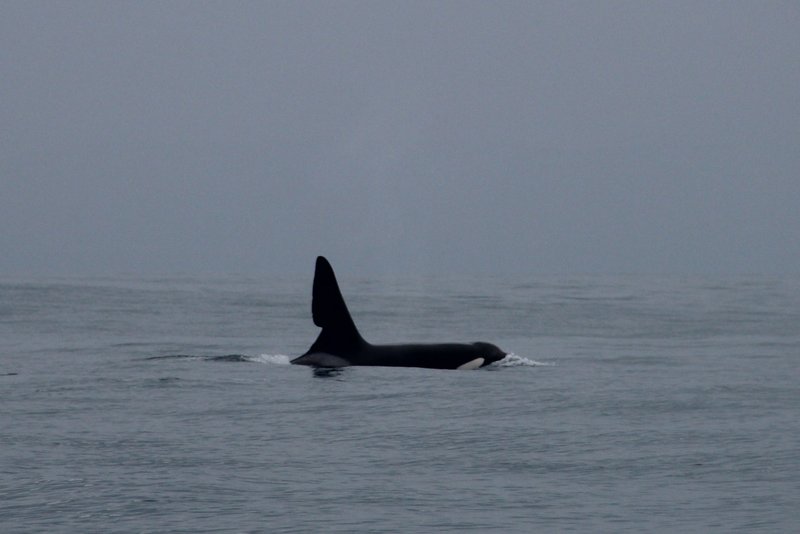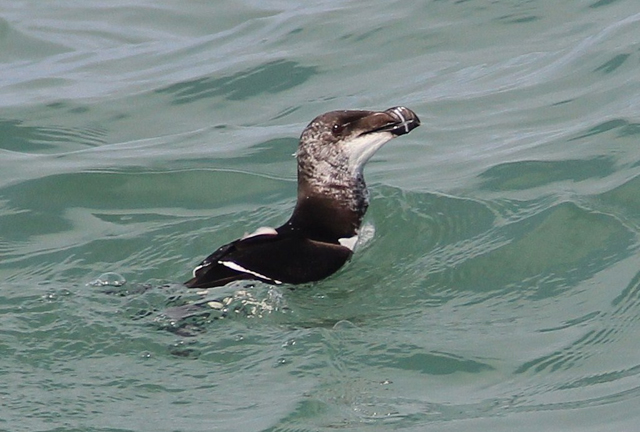Bucket List of 10 most iconic species of animals.
Killer whale "John Coe"

Wildlife Name 2

Shark Attack!
Puffins - Penguins - Killer Whales - Great White Shark - Basking Shark - Polar Bears - Seals - Snowy Owls - Snow Leopard - Humpback Whales.......
10 Most Iconic Species of Animals
If you just think of the 10 most iconic species of animals vaguely associated with the sea or high latitudes and high altitudes the above list is the list that I made.
The list can be further broken down into:
Birds (3) - Puffins; Penguins; Snowy Owls.
Fish (2) - Basking Shark; Great White Shark
Cetaceans (2) - Killer Whales; Humpback Whales
Marine Mammals (2) - Polar Bears; Seals
Land Mammals (1) - Snow Leopard
Question: Of these 10 iconic species of birds, fish, cetaceans, marine and land mammals how many can be seen around the Blasket Islands, a European designated S.A.C. [Special Area of Conservation] and S.P.A. [Special Protected Area] on a boat tour with Blasket Islands Eco Marine Tours from Ventry Harbour in West Kerry on the Dingle Peninsula in Ireland S.W.?
Answer: An incredible 7 out of 10 of these iconic animals can occasionally be seen!!!
Puffins; Penguins; Snowy Owls; Basking Shark; Great White Shark
1. Puffins: Yes, we see puffins as there are about 2,000 breeding pairs on the outer Blasket Islands during the summer months until they migrate back into the North Atlantic towards Canadian waters at the end of July / beginning of August.
2. Penguins: No, we don't have penguins naturally occurring in the northern hemisphere [ apart from puffins who may qualify as honorary penguins (?)] but we have Gentoo penguins - from Spanish word "Juanito" for John hence the common name "Johnny Penguins" - who normally live on the sub-Antarctic islands like the Falklands, now living and breeding in the Dingle Ocean World, in Dingle town, so yes you can now see penguins on the Dingle Peninsula!!
3. Snowy Owls: Snowy owls are rare and beautiful birds of prey [raptors] that normally inhabit the sub-Arctic regions of North America and Eurasia and recently made famous through Hedwig the female snowy owl in the Harry Potter books by J.R. Rowling. A snowy owl was spotted a few times during the summer of 2019 on the Great Blasket Island, on one occasion when a visitor disturbed it at its roost and possible hunting spot as it adapts a "sit and prey" hunting technique while hunting for animals like leverets [young hares] and small mammals which are plentiful on the hills there. Unlike many other owls it is diurnal and often hunts during the day in summer time when food is plentiful. Most Snowy Owls spotted this far south may be young owls going through a youthful nomadic exploratory phase or may be due to irruptive breeding patterns in the home ground when either there are larger and more successful than normal broods and /or scarcity of local food resources.
So that is 3 out of 3 for iconic birds to see in and around the Blasket Islands and Dingle !!
4. Basking Shark: The West Kerry coast is a great place for spotting Basking Shark for about a 6 week period in April and May when they come to the surface to feed on the Spring plankton blooms when the surface sea water temperature is about 12 degrees Celsius
5. Great White Shark: We do not have Great White Shark off the Blaskets so far.! They tend to come as far as the mid-Atlantic ridge from the east coast of North America and then turn back. There are lots of Great White Shark off Seal Island in South Africa where conditions are very similar to those off the Blasket Islands with similar sea water temperatures and plenty of seals. Sea water temperatures off the S.W. of Ireland range from approx. 8 degrees Celsius in mid-March to approx. 18 degrees Celsius in mid-September giving an average annual sea water temperature of 13 degrees Celsius and above 11 degrees Celsius from beginning of May to end of December. Great Whites are comfortable in sea water temperatures of about 11.5 degrees Celsius upwards so they may become seasonal migrants first before becoming permanent residents when sea water temperatures rise further in the next few decades with global warming [ forecast to rise by 3.5 degrees Celsius by 2100.] Even in winter Great Whites could also hang out in the warm Gulf Stream currents and eddies off the west coast of Ireland and make occasional hunting forays into the colder inshore waters with plentiful supplies of seals and seal pups. It may be that with massively increasing seal populations off the west coasts of Scotland and Ireland it seems inevitable that we will get Great White Sharks predating on them eventually, as they were here after the last ice age and they are also native to the Mediterranean where they have been fished nearly [but not quite] to extinction, although there is some mitochondrial DNA evidence that the Mediterranean population may be an isolated population still remaining after a free ranging dispersal event from the Pacific ocean about 250,000 years ago rather than being a population refreshed by fresh Atlantic stock through the Straits of Gibraltar. With increasing sea water temperatures sending fish like mackerel and cod further north towards Iceland, species like hake now very plentiful in Irish waters as well as sardines and anchovies; moray eels now competing for suitable habitat with "native" conger eels and formerly unknown semi-tropical fish like trigger fish now permanent in Irish waters, perhaps a further increase in sea water temperatures (or rather a decrease in minimum cold water temperatures to about 11 degrees) will bring inquisitive pioneering Great White Sharks to our shores, as one of the results of anthropogenic climate warming is that warmer water aids the redistribution of many species. All it takes is one to redistribute successfully and find new feeding grounds and the rest will follow.........
After all the human species did this type of population redistribution to America less than 500 years ago!
So that is 4 out of 5 so far for iconic species!!!!
Killer Whales; Humpback Whales; Polar Bears; Seals; Snow Leopard.
6. Killer Whales: Killer Whales are scarce in Irish waters but we do see them occasionally. They mostly belong to the so called Scottish West Coast Community of Killer Whales, a community of Killer Whales based off the west coast of Scotland in the area around the Hebrides Islands, who are mainly herring and mackerel hunters but do the occasional Circuit of Ireland once or twice a year and sometimes we are lucky enough to see some of their members, particularly an individual named John Coe and his companion Aquarius spotted off the west coast of Clare in 2019 and off West Kerry in 2018. Previous to that they were seen with another male Floppy Fin in Dingle Bay and Brandon Bay in October 2016 and the fact that they are travelling as males only rather than in a matriarchal group as normal does not bode well for their long term survivability. Unfortunately, possibly because of the high level of pollutants found in their tissues and organs as a result of their diet as apex predators, which may affect their reproductive status, this pod of Killer Whales has not produced any known viable offspring in the last twenty five years and they may be on the verge of extinction and down to the last two or three males. There is another community of Killer Whales off the north coast of Scotland called the Northern Isles Community comprising 9 members with two juvenile members which is a healthy proportion of juveniles to adults in the pod which consists of 2 males, 2 juveniles and 5 females.
In late July 2019 an unidentified pod of 9 Killer Whales was spotted off the west coast of Scotland by a Hebredian Whale and Dolphin Trust survey vessel. This is exciting news in the small Killer Whale watching community and there is conjecture at the moment that this group may be a nomadic group of offshore Killer Whales from Iceland who are scoping out the west coasts of Scotland and Ireland.
Recently [December 2019] a Killer Whale, belonging to another pod, possibly a seal eating orca community, has been identified in the Mediterranean off Italy, that was previously photo identified off Iceland, so no doubt Killer Whales are regularly cruising off the west coast of Ireland as they migrate south towards the Straits of Gibraltar and the Mediterranean in pursuit of tuna. Individual Killer Whales can be identified by the individually distinctive markings on the grey "saddle patch" behind the dorsal fin and of course males can be easily identified by the proportionally taller dorsal fin, up to 6 ft. tall in large males, which is the tallest dorsal fin of all cetaceans.
That makes it 5 out of 6 iconic animals so far that can be seen around the Blasket Islands and Dingle Bay, Co. Kerry, Ireland S.W.!
7. Humpback Whales: Yes, we see humpback whales on a fairly regular basis around the Blaskets as they migrate from the feeding ground of the high northern latitudes of Iceland and Norway to the breeding grounds in warmer southern latitudes like the Cape Verde Islands off West Africa and possibly further west towards the Silver Banks off the Dominican Republic in the Caribbean.
94 individual animals have so far been identified in the Irish Humpback Whale Catalogue, as collated by the IWDG [Irish Whale and Dolphin Group], since the first individual was photo identified in the Kinsale Gas Field in September 1999 giving an average of just under 5 new individual Humpback Whales added to the Irish Humpback Whale Catalogue each year, with many more repeated re-sightings of previously known individuals. Photo identification is obtained from the unique colouration pattern and pigmentation on the ventral tail flukes which is unique to each individual like finger printing for humans.
8. Polar Bears: No, we have no Polar Bears around the Blaskets! We may have to wait until the next ice age or glaciation period (if Polar Bears are still around) which may be due in about 7,000 years - unless interrupted by global warming- as it is about 13,000 years since the last ice age ended and glaciation periods usually last for about 90,000 years and interglacial periods, like the present, for only about 20,000 years max.
9. Seals: Yes, we have lots of seals around the Blaskets! In fact it now appears that we may have as many seals around the Blaskets as on the Insihkea Islands off the Mayo coast and on any day during the winter you can count up to 2,000 seals hauled out on the Trá Bán [White Strand] on the Great Blasket Island. Luckily for them the Killer Whales passing by are fish eaters [herring and mackerel] not mammal eaters [apart from the occasional Harbour Porpoise] and the Great White Sharks have not arrived yet..........
10. Snow Leopard: But sadly no possibility of seeing a Snow Leopard around the Blaskets (!) but I felt that we had to include it in our list of iconic animals.You would have to travel to the most rugged and isolated parts of the world which they inhabit, like the Himalayas, to see this iconic animal.
Our final score for possibility of seeing some of the most iconic animals on the planet around the Blasket islands and Dingle Bay is an incredible 7 out of 10 (!) but please do not expect to see all or even any on a given day (!) on a tour with Blasket Islands Eco Marine Tours from Ventry Harbour, West Kerry as the sea is wide and deep and our boat is small (relatively) and the animals are free. But if you are lucky and observant and conditions are suitable and the animals are passing by you may expect to see in descending order - Seals (always); Puffins (April to end of July); Penguins (Dingle Ocean World); Basking Shark (April, May); Humpback Whales (April to September); Killer Whales (unpredictable visitors); Snowy Owl (once in a very blue moon) - but please do not expect to see - Polar Bears; Great White Shark or Snow Leopards!!!!!!!!
Log of Whale Watching Tour Boat M.V. Blasket Princess"
Captain Whales Galore 11.01.2020

























